超宽带技术的短期或中期范围内的无线通信-毕业论文外文翻译
浅谈超宽带无线通信技术的发展
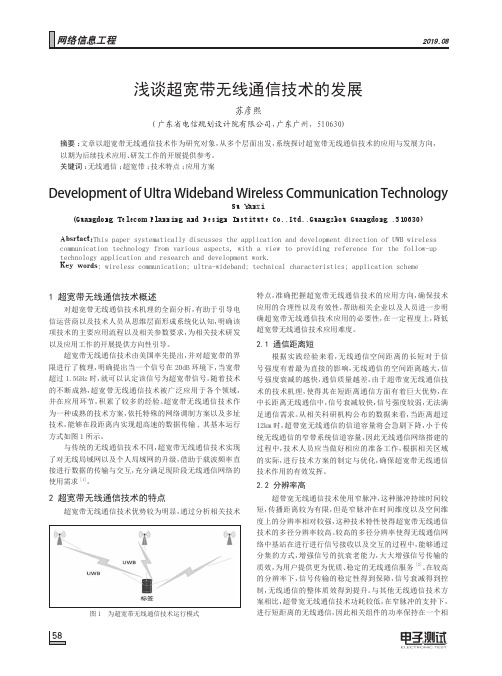
对超宽带无线通信技术机理的全面分析,有助于引导电信运营商以及技术人员从思维层面形成系统化认知,明确该项技术的主要应用流程以及相关参数要求,为相关技术研发以及应用工作的开展提供方向性引导。
超宽带无线通信技术由美国率先提出,并对超宽带的界限进行了梳理,明确提出当一个信号在20dB 环境下,当宽带超过1.5GHz 时,就可以认定该信号为超宽带信号。
随着技术的不断成熟,超宽带无线通信技术被广泛应用于各个领域,并在应用环节,积累了较多的经验。
超宽带无线通信技术作为一种成熟的技术方案,依托特殊的网络调制方案以及多址技术,能够在段距离内实现超高速的数据传输,其基本运行方式如图1所示。
与传统的无线通信技术不同,超宽带无线通信技术实现了对无线局域网以及个人局域网的升级,借助于载波频率直接进行数据的传输与交互,充分满足现阶段无线通信网络的使用需求[1]。
2 超宽带无线通信技术的特点超宽带无线通信技术优势较为明显,通过分析相关技术应用的合理性以及有效性,帮助相关企业以及人员进一步明确超宽带无线通信技术应用的必要性,在一定程度上,降低超宽带无线通信技术应用难度。
2.1 通信距离短根据实践经验来看,无线通信空间距离的长短对于信号强度有着最为直接的影响,无线通信的空间距离越大,信号强度衰减的越快,通信质量越差。
由于超带宽无线通信技术的技术机理,使得其在短距离通信方面有着巨大优势,在中长距离无线通信中,信号衰减较快,信号强度较弱,无法满足通信需求。
从相关科研机构公布的数据来看,当距离超过12km 时,超带宽无线通信的信道容量将会急剧下降,小于传统无线通信的窄带系统信道容量,因此无线通信网络搭建的过程中,技术人员应当做好相应的准备工作,根据相关区域的实际,进行技术方案的制定与优化,确保超宽带无线通信技术作用的有效发挥。
2.2 分辨率高超带宽无线通信技术使用窄脉冲,这种脉冲持续时间较短,传播距离较为有限,但是窄脉冲在时间维度以及空间维度上的分辨率相对较强,这种技术特性使得超宽带无线通信技术的多径分辨率较高。
本科毕业论文中英文翻译--Wireless-Communications无线通信【范本模板】
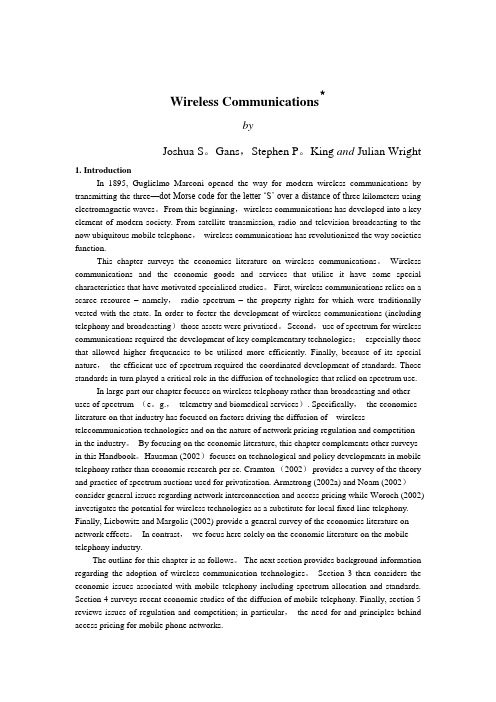
Wireless Communications*byJoshua S。
Gans,Stephen P。
King and Julian Wright1. IntroductionIn 1895, Guglielmo Marconi opened the way for modern wireless communications by transmitting the three—dot Morse code for the letter ‘S’ over a distance of th ree kilometers using electromagnetic waves。
From this beginning,wireless communications has developed into a key element of modern society. From satellite transmission, radio and television broadcasting to the now ubiquitous mobile telephone,wireless communications has revolutionized the way societies function.This chapter surveys the economics literature on wireless communications。
Wireless communications and the economic goods and services that utilise it have some special characteristics that have motivated specialised studies。
First, wireless communications relies on a scarce resource –namely,radio spectrum –the property rights for which were traditionally vested with the state. In order to foster the development of wireless communications (including telephony and broadcasting)those assets were privatised。
外文翻译--超宽带技术的短期或中期范围内的无线通信
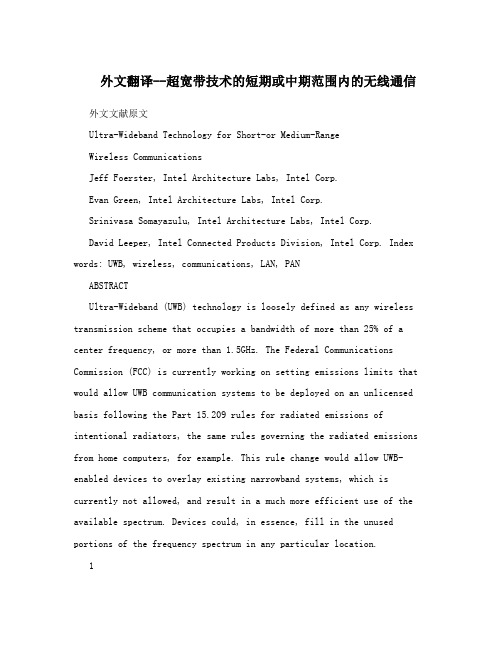
外文翻译--超宽带技术的短期或中期范围内的无线通信外文文献原文Ultra-Wideband Technology for Short-or Medium-RangeWireless CommunicationsJeff Foerster, Intel Architecture Labs, Intel Corp.Evan Green, Intel Architecture Labs, Intel Corp.Srinivasa Somayazulu, Intel Architecture Labs, Intel Corp.David Leeper, Intel Connected Products Division, Intel Corp. Index words: UWB, wireless, communications, LAN, PANABSTRACTUltra-Wideband (UWB) technology is loosely defined as any wireless transmission scheme that occupies a bandwidth of more than 25% of a center frequency, or more than 1.5GHz. The Federal Communications Commission (FCC) is currently working on setting emissions limits that would allow UWB communication systems to be deployed on an unlicensed basis following the Part 15.209 rules for radiated emissions of intentional radiators, the same rules governing the radiated emissions from home computers, for example. This rule change would allow UWB-enabled devices to overlay existing narrowband systems, which is currently not allowed, and result in a much more efficient use of the available spectrum. Devices could, in essence, fill in the unused portions of the frequency spectrum in any particular location.1These recent developments by the FCC give Intel a unique opportunity to develop equipment that could potentially take advantage of the vast amount of usable spectrum that exists in the wireless space, and that could provide an engine to drive the future high-rate applications that are being conceived throughout this industry.Intel? Architecture Labs (IAL) is currently researching UWB technology in order to better understand its benefits, limitations, and technical challenges when used for high-rate communications. This paper introduces the reader to this technology, from potential applications to regulatory hurdles, to possible implementations and future challenges. INTRODUCTIONUltra-Wideband (UWB) technology has been around since the 1980s, but it has been mainly used for radar-based applications until now (see [1] and the references therein), because of the wideband nature of thesignal that results in very accurate timing information. However, due to recent developments in high-speed switching technology, UWB is becoming more attractive for lowcost consumer communications applications (as detailed in the “Implementation Advantages” section of this paper). Intel Architecture Labs (IAL) is currently working on an internally funded research project whose intent is to further explore the potential benefits and future challenges for extending UWB technology into the high-rate communications arena.2Although the term Ultra-Wideband (UWB) is not very descriptive, itdoes help to separate this technology from more traditional “narrowband” systems as well as newer “wideband” systems typically referred to in theliterature describing the future 3G cellular technology. There aretwo main differences between UWB and other “narrowband” or “wideband” systems. First, the bandwidth of UWB systems, as defined by the Federal Communications Commission (FCC) in [2], is more than 25% ofa center frequency or more than 1.5GHz. Clearly, this bandwidth is much greater than the bandwidth used by any current technology for communication. Second, UWB is typically implemented in a carrierlessfa shion. Conventional “narrowband” and “wideband” systems use Radio Frequency (RF) carriers to move the signal in the frequency domain from baseband to the actual carrier frequency where the system is allowed to operate. Conversely, UWB implementations can directly modulate an “impulse” that has a very sharp rise and fall time, thus resulting ina waveform that occupies several GHz of bandwidth. Although there are other methods for generating a UWB waveform (using a chirped signal, for example), in this paper, we focus on the impulse-based UWB waveform. but, first, a breakdown of how this paper is organized. WIRELESS ALTERNATIVES In order to understand where UWB fits in with the current trends in wireless communications, we need to consider the general problem that3communications systems try to solve. Specifically, if wireless werean ideal medium, we could use it to send.1. a lot of data,2. very far,3. very fast,4. for many users,5. all at once.Unfortunately, it is impossible to achieve all five attributes simultaneously for systems supporting unique, private, two-way communication streams; one or more have to be given up if the others are to do well. Original wireless systems were built to bridge large distances in order to link two parties together. However, recent history of radio shows a clear trend toward improving on the other four attributes at theexpense of distance. Cellular telephony is the most obvious example, covering distances of 30 kilometers to as little as 300 meters. Shorter distances allow for spectrum reuse, thereby serving more users, and the systems are practical because they are supported by an underlying wired infrastructure– the telephone network in the case of cellular. In the past few years, even shorter range systems, from 10 to 100 meters, have begun emerging, driven primarily by data applications. Here, the Internet is the underlying wired infrastructure, rather than the telephone network. Many expect the combination of short-range wireless and wired Internet to4become a fast-growing complement to next generation cellular systems for data, voice, audio, and video. Four trends are driving short-range wireless in general and ultra-wideband in particular:1. The growing demand for wireless data capability in portabledevices at higher bandwidth but lower in cost and power consumption than currently available.2. Crowding in the spectrum that is segmented and licensed by regulatory authorities in traditional ways.3. The growth of high-speed wired access to the Internet in enterprises,homes, and public spaces.4. Shrinking semiconductor cost and power consumption for signal processing.Trends 1 and 2 favor systems that offer not just high-peak bit rates, but high spatial capacity1 as well, where spatial capacity is defined as bits/sec/square-meter. Just as the telephone network enabledcellulartelephony, Trend 3 makes possible high-bandwidth, in-buildingservice provision to low-power portable devices using short-range wireless standards like Bluetooth () and IEEE 802.11 (). Finally, Trend4 makes possible the use of signal processing techniques that would have been impractical only a few years ago. It is this final trend that makes Ultra-Wideband (UWB) technology practical. When used as intended, the emerging short- and5medium-range wireless standards vary widely in their implicitspatial capacities. For example :1.IEEE 802.11b has a rated operating range of 100 meters. In the2.4GHz ISM band, there is about 80MHz of useable spectrum. Hence, in a circle with a radius of 100 meters, three 22MHz IEEE 802.11b systems can operate on a non-interfering basis, each offering a peak over-the-air speed of 11Mbps. The total aggregate speed of 33Mbps, divided by thearea of the circle, yields a spatial capacity of approximately 1,000bits/sec/square-meter.2.Bluetooth, in its low-power mode, has a rated 10-meter range and a peak over-the-air speed of 1Mbps. Studies have shown that approximately 10 Bluetooth “piconets” can operate simultaneously in the same 10-meter circle with minimal degradation yielding an aggregate speed of10Mbps [3]. Dividing this speed by the area of the circle produces a spatial capacity of approximately 30,000bits/sec/square-meter.3.IEEE 802.11a is projected to have an operating range of 50 meters and a peak speed of 54Mbps. Given the 200MHz of available spectrumwithin the lower part of the 5GHz U-NII band, 12 such systems canoperate simultaneously within a 50-meter circle with minimal degradation, for an aggregate speed of 648Mbps. The projected spatial capacity ofthis system is therefore approximately 83,000 bits/sec/square-meter.64.UWB systems vary widely in their projected capabilities, but one UWB technology developer has measured peak speeds of over 50Mbps at a range of 10 meters and projects that six such systems could operate within the same 10-meter radius circle with only minimal degradation. Following the same procedure, the projected spatial capacity for this system would be over 1,000,000 bits/sec/square-meterCurrent low data-rate Wireless Local Area Networks (WLANs) and Wireless Personal Area Networks (WPANs), which have data rates of ~1-10Mbps, are typically used for applications such as packet-switched data and cordless voice telephony, using Time Division Multiple Access (TDMA) voice circuits. Example technologies supporting these applications are the IEEE 802.11b (Wi-Fi)*, Bluetooth?, and HomeRF*networking standards. As the IEEE 802.11 and ETSI BRANHiperLAN/2* standards (the European equivalent of 802.11) have added physical layer specifications with raw data rates up to 54Mbps, the application space is enlarging to include audio/video applications that are enabled by these higher data rates. These diverse traffic types all have different requirements in terms of the service parameters that quantify the network performance for a user of each of those applications. Thus, for example, voice telephony and video teleconferencing applications place tough demands on the latency and jitter performance. Audio/video applications require large amounts of bandwidth and may need close7synchronization (e.g., connecting stereo speakers in a surround sound system). Ultra-Wideband (UWB) systems, with their potential for extremely large data rates over short distances, are naturally going to be used for networking these kinds of high-bandwidth/delaycritical data sources and sinks. Hence, it would be natural to look at the approaches to the MAC design undertaken in these other standards when considering the MAC layer design for UWB systems. The most important functions of the MAC layer for a wireless network include controlling channel access, maintaining Quality of Service (QoS), and providing security.8外文文献翻译超宽带技术的短期或中期范围内的无线通信杰夫福斯特~英特尔架构实验室~英特尔公司埃文格林~英特尔架构实验室~英特尔公司斯里尼瓦萨~英特尔架构实验室~英特尔公司大卫利珀~英特尔部连接的产品~英特尔公司关键字:超宽带~无线~通讯~局域网~无源光网络摘要超宽带,UWB,技术可以大致的被定义为一个占有超过25,中心频率的带宽~或者涨幅比为1.5GHz的带宽的任何无线传输方案。
超宽带无线通信技术如何发展论文

超宽带无线通信技术如何开展论文超宽带无线通信技术在人们生活中的出现和应用,给人们提供了极大的便利,也使得人们之间的交流变得更加通畅和舒适。
近年来随着技术的不断开展,超高宽带通信技术取得了较快开展,为我国的经济和社会开展做出了极大的奉献。
为此,文章对超宽带无线通信技术概念、特点及其未来开展情况进行了探析。
1.1超宽带无线通信技术的概念超宽带无线通信技术是在传统无线通信技术的根底上开展起来的,其将宽带的流通速度和范围都在一定程度上进行了提高,实现了很大程度的突破。
当前,超宽带无线通信技术在应用过程中,主要在传播介质方面进行了改变。
超宽带无线通信技术应用的是短波脉冲信号,所以其信号发射持续时间有限,但能够占据的频率和级别却很高,所以说超宽带无线通讯技术在传输速度上实现了惊人的提升。
1.2超宽带无线通信技术的特点目前,超宽带无线通信技术已经普遍的应用到家庭、办公、交通、军事、网络媒体等多个方面了。
其能够在取得如此大的成就,与其应用特点是分不开的,主要表达在一下几个方面。
第一,数据传输速度快。
超宽带无线通信技术在传输中应用的是到达千兆赫之上的超级宽带,所以其在数据传输中速度是非常快速的。
第二,数据传输距离短。
在信号的传输过程中,信号受到距离和高频信号的影响之后会出现信号强度减弱的现象,所以在使用过程中更加适合短距离数据的传输。
第三,凭据发射功率低。
在距离较短的通信中进行超宽带无线通信技术的应用,其发射功率一般都在1mW以下,在这种情况下超宽带与窄宽带之间能够到达很好的平衡性,从而促进无线频谱使用效率的提升,使得无线频谱资源紧张问题得到有效的控制。
第四,多径分辨率高。
超宽带具有一定的隐蔽性,所以其保密性能是很强大的,而且其在应用过程中采用的是持续时间极端的窄脉冲,所以其分辨率很好,能够为定位、测量以及追踪提供便利。
同时,窄脉冲的高穿透性也有利于其在红外线通信中的应用。
第五,便捷性。
超宽带技术使用的是基带传输技术,而且设备体积小,本钱低,应用起来灵活便捷,适用于便携型通讯的使用。
5G无线通信网络中英文对照外文翻译文献
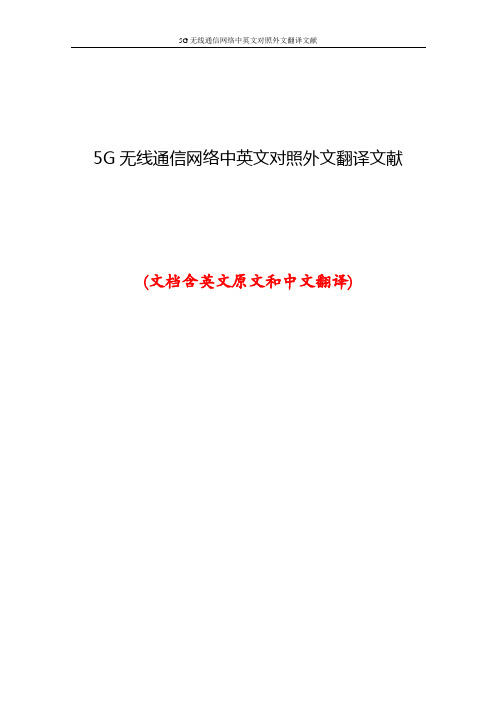
5G无线通信网络中英文对照外文翻译文献(文档含英文原文和中文翻译)翻译:5G无线通信网络的蜂窝结构和关键技术摘要第四代无线通信系统已经或者即将在许多国家部署。
然而,随着无线移动设备和服务的激增,仍然有一些挑战尤其是4G所不能容纳的,例如像频谱危机和高能量消耗。
无线系统设计师们面临着满足新型无线应用对高数据速率和机动性要求的持续性增长的需求,因此他们已经开始研究被期望于2020年后就能部署的第五代无线系统。
在这篇文章里面,我们提出一个有内门和外门情景之分的潜在的蜂窝结构,并且讨论了多种可行性关于5G无线通信系统的技术,比如大量的MIMO技术,节能通信,认知的广播网络和可见光通信。
面临潜在技术的未知挑战也被讨论了。
介绍信息通信技术(ICT)创新合理的使用对世界经济的提高变得越来越重要。
无线通信网络在全球ICT战略中也许是最挑剔的元素,并且支撑着很多其他的行业,它是世界上成长最快最有活力的行业之一。
欧洲移动天文台(EMO)报道2010年移动通信业总计税收1740亿欧元,从而超过了航空航天业和制药业。
无线技术的发展大大提高了人们在商业运作和社交功能方面通信和生活的能力无线移动通信的显著成就表现在技术创新的快速步伐。
从1991年二代移动通信系统(2G)的初次登场到2001年三代系统(3G)的首次起飞,无线移动网络已经实现了从一个纯粹的技术系统到一个能承载大量多媒体内容网络的转变。
4G无线系统被设计出来用来满足IMT-A技术使用IP面向所有服务的需求。
在4G系统中,先进的无线接口被用于正交频分复用技术(OFDM),多输入多输出系统(MIMO)和链路自适应技术。
4G无线网络可支持数据速率可达1Gb/s的低流度,比如流动局域无线访问,还有速率高达100M/s的高流速,例如像移动访问。
LTE系统和它的延伸系统LTE-A,作为实用的4G系统已经在全球于最近期或不久的将来部署。
然而,每年仍然有戏剧性增长数量的用户支持移动宽频带系统。
扩频技术外文翻译
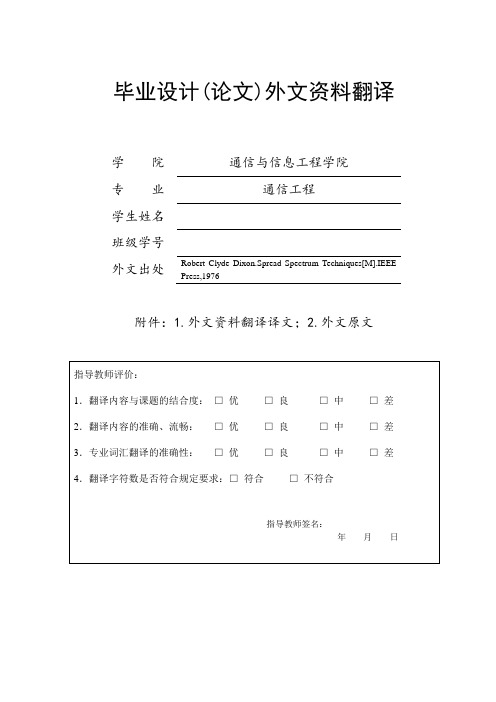
毕业设计(论文)外文资料翻译学院通信与信息工程学院专业通信工程学生姓名班级学号外文出处Robert Clyde Dixon.Spread Spectrum Techniques[M].IEEE Press,1976附件:1.外文资料翻译译文;2.外文原文附件1:外文资料翻译译文扩频技术摘要扩频技术是信号(例如一个电气、电磁,或声信号)生成的特定带宽频率域中特意传播,从而导致更大带宽的信号的方法。
这些技术用于各种原因包括增加抗自然干扰和干扰,以防止检测,并限制功率流密度(如在卫星下行链路)的安全通信设立的。
跳频的历史:跳频的概念最早是归档在1903年美国专利723188和美国专利725605由尼古拉特斯拉在1900年7月提出的。
特斯拉想出了这个想法后,在1898年时展示了世界上第一个无线电遥控潜水船,却从“受到干扰,拦截,或者以任何方式干涉”发现无线信号控制船是安全的需要。
他的专利涉及两个实现抗干扰能力根本不同的技术,实现这两个功能通过改变载波频率或其他专用特征的干扰免疫。
第一次在为使控制电路发射机的工作,同时在两个或多个独立的频率和一个接收器,其中的每一个人发送频率调整,必须在作出回应。
第二个技术使用由预定的方式更改传输的频率的一个编码轮控制的变频发送器。
这些专利描述频率跳变和频分多路复用,以及电子与门逻辑电路的基本原则。
跳频在无线电报中也被无线电先驱约翰内斯Zenneck提及(1908,德语,英语翻译麦克劳希尔,1915年),虽然Zenneck自己指出德律风根在早几年已经试过它。
Zenneck的书是当时领先的文本,很可能后来的许多工程师已经注意到这个问题。
一名波兰的工程师(Leonard Danilewicz),在1929年提出了这个想法。
其他几个专利被带到了20世纪30年代包括威廉贝尔特耶斯(德国1929年,美国专利1869695,1932)。
在第二次世界大战中,美国陆军通信兵发明一种称为SIGSALY的通信系统,使得罗斯福和丘吉尔之间能相互通信,这种系统称为扩频,但由于其高的机密性,SIGSALY的存在直到20世纪80年代才知道。
超宽带无线通信
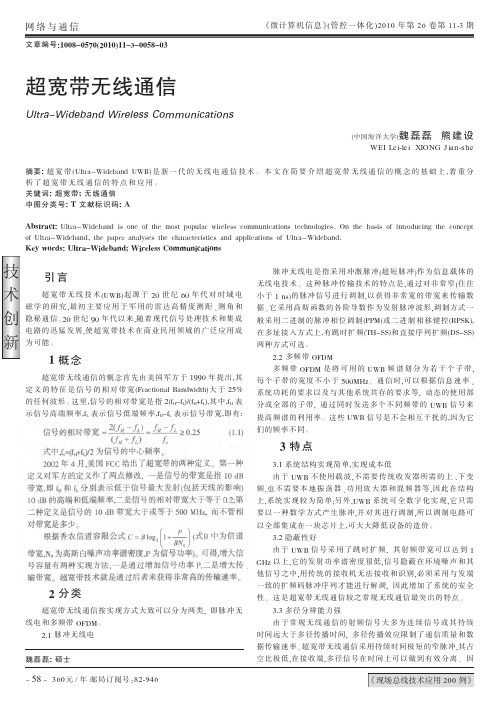
技术创新《微计算机信息》(管控一体化)2010年第26卷第11-3期360元/年邮局订阅号:82-946《现场总线技术应用200例》网络与通信超宽带无线通信Ultra-Wideband Wireless Communications(中国海洋大学)魏磊磊熊建设WEI Lei-lei XIONG Jian-she摘要:超宽带(Ultra-Wideband UWB)是新一代的无线电通信技术。
本文在简要介绍超宽带无线通信的概念的基础上,着重分析了超宽带无线通信的特点和应用。
关键词:超宽带;无线通信中图分类号:T 文献标识码:AAbstract:Ultra-Wideband is one of the most popular wireless communications technologies.On the basis of introducing the concept of Ultra-Wideband,the paper analyses the characteristics and applications of Ultra-Wideband.Key words:Ultra-Wideband;Wireless Communications文章编号:1008-0570(2010)11-3-0058-03引言超宽带无线技术(UWB)起源于20世纪60年代对时域电磁学的研究,最初主要应用于军用的雷达高精度测距、测角和隐秘通信。
20世纪90年代以来,随着现代信号处理技术和集成电路的迅猛发展,使超宽带技术在商业民用领域的广泛应用成为可能。
1概念超宽带无线通信的概念首先由美国军方于1990年提出,其定义的特征是信号的相对带宽(Fractional Bandwidth)大于25%的任何波形。
这里,信号的相对带宽是指2(f H -f L )/(f H +f L ),其中,f H 表示信号高端频率,f L 表示信号低端频率,f H -f L 表示信号带宽,即有:信号的相对带宽(1.1)式中,f c =(f H +f L )/2为信号的中心频率。
通信工程 毕业设计 外文文献翻译:超宽带系统的数据通信
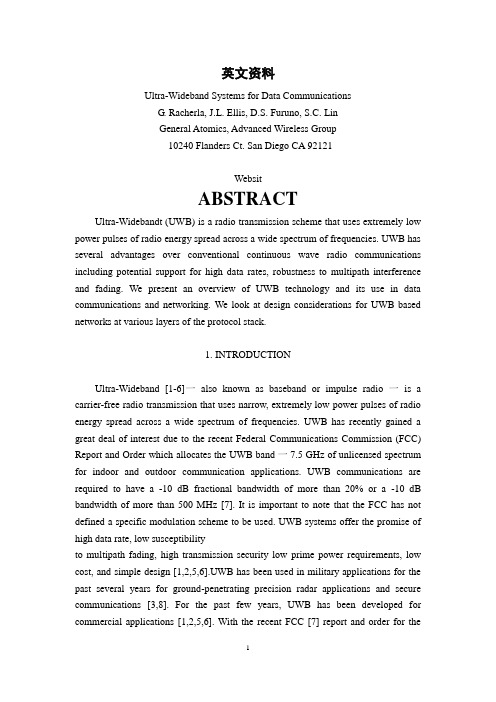
英文资料Ultra-Wideband Systems for Data CommunicationsG. Racherla, J.L. Ellis, D.S. Furuno, S.C. LinGeneral Atomics, Advanced Wireless Group10240 Flanders Ct. San Diego CA 92121WebsitABSTRACTUltra-Widebandt (UWB) is a radio transmission scheme that uses extremely low power pulses of radio energy spread across a wide spectrum of frequencies. UWB has several advantages over conventional continuous wave radio communications including potential support for high data rates, robustness to multipath interference and fading. We present an overview of UWB technology and its use in data communications and networking. We look at design considerations for UWB based networks at various layers of the protocol stack.1.INTRODUCTIONUltra-Wideband [1-6]一also known as baseband or impulse radio一is a carrier-free radio transmission that uses narrow, extremely low power pulses of radio energy spread across a wide spectrum of frequencies. UWB has recently gained a great deal of interest due to the recent Federal Communications Commission (FCC) Report and Order which allocates the UWB band一7.5 GHz of unlicensed spectrum for indoor and outdoor communication applications. UWB communications are required to have a -10 dB fractional bandwidth of more than 20% or a -10 dB bandwidth of more than 500 MHz [7]. It is important to note that the FCC has not defined a specific modulation scheme to be used. UWB systems offer the promise of high data rate, low susceptibilityto multipath fading, high transmission security low prime power requirements, low cost, and simple design [1,2,5,6].UWB has been used in military applications for the past several years for ground-penetrating precision radar applications and secure communications [3,8]. For the past few years, UWB has been developed for commercial applications [1,2,5,6]. With the recent FCC [7] report and order for theuse of UWB technology, there has been an added impetus to this endeavor. Other notable UWB applications include collision avoidance radar, tagging/identification; geolocation [9] and data communications in personal area networks (PAN) and local area network (LAN) environments.There are several future challenges to the wide adoption of UWB for wireless data communications including the infancy of the technology in the commercial arena, lack of reliablechannel models, the early stages of standardization effort and lack of low-cost system on chip (SoC) implementations. In this paper, we look at UWB technology for data communications and inside a UWB physical (PHY) layer characteristics. We also briefly introduce other related wireless standards such as 802.11 [10], 802.15.3 [11-13] Bluetooth [14], HomeRF [15] and HIPERLAN [16] and present a brief synopsis of the regulatory effort worldwide with special emphasis on the FCC. We also present the design considerations for UWB based data networking.2.ULTRA-WIDEBAND TECHNOLOGYThe basic waveform that employed in a UWB system is an approximation to an impulse, such as that shown in Fig. 1. The short duration of the pulse is associated with large inherent bandwidth; hence, the nomenclature "Ultra-Wideband". Typical attributes of UWB waveforms are summarized in Table 1.Fig. 1. UWB waveform example.The high spectral content of the UWB waveform gives rise to one of the primary advantages UWB operation for communications where a UWB system is robust against multipath fading[17] and narrowband interference [18]. In multipath fading, where the transmitted radio frequency (rt) signal can reflect off objects in its transmission path and can cause destructive interferences at the receiver, a loss of reception can occur. ThisTable 1: Characteristics of Typical UWB SystemsFractional Bandwidth > 20%Pulse Width 0.1-2 asPulse Repetition Frequency 1 kHz-2 GHzAverage Transmitted Power<1mWeffect is particularly problematic indoors where there are many reflecting surfaces. In the frequency domain, multipath is shown as frequency selective fading. Because UWB communications systems spreads the transmitted data over a broad frequency band if destructive interference occurs at a specific frequency, whether due to multipath or narrowband interference, the information can still be recovered over the good frequencies.UWB implementations can provide low complexity, low cost solutions [19], thus enabling vast deployments of the technology. A critical component that reaffirms a low cost solution is noting that UWB signals, being carrier-less, have greater simplicity over narrowband transceivers and require smaller silicon die sizes [20]. UWB can be designed to achieve very high bit rates while still achieving low power consumption, a feature set which will be exploited by the consumer electronics industry [21]. UWB schemes can further be designed to be very scalable in terms of complexity, bit rate, power consumption, and range.UWB technology can support many applications. Different UWB modulation schemes offer different advantages for communication, radar, and precisiongeo-location applications. UWB technology, which operates between 3.1 and 10.6 GHz, intrinsically offers an efficient reuse of precious spectrum by operating stealthily at the noise floor [22]. This UWB system operates at low power, to be compliant with operating under FCC Part 15 emissions, across a wide range of frequencies. As a spread spectrum technology, UWB offers a low probability of intercept and a low probability of detection [8]. Thus, it is particularly well suited for covert military or sensitive usage seenarios [8]. Because UWB signals have extremely short bursts in time (e.g., durations of 1 ns or less) they are suited for precision geo-location applications. Though UWB intrinsically offers the above-mentioned features, application optimization and improvements on these characteristics are left to specific designs and implementations, most notably by careful consideration of modulation schemes.2.1. UWB System Design ConsiderationsSeveral considerations are needed when designing a PAN. First, low power design is necessary because the portable devices within the network are battery powered. Second, high data rate transmission is crucial for broadcasting multiple digi\tal audio and video streams: Lastly, low cost is a prerequisite to broadening consumer adoption. In addition to these criteria, the UWB system designer must address synchronization and coexistence. Capturing and locking onto these short pulses make synchronization a non-trivial task. Coexisting peacefully with other wireless systems without interference is important;In particular, one needs to pay attention to the 802.1 la wireless LANs that operate in the 5 GHz ISM bands.At the physical layer, additional challenges lie in the transceiver and antenna design. At the transmitter, pulse shaping is required to produce flat and wideband emission in the desired frequency bands. Although new integrated circuits provide less expensive forms of integration, the pulses can be affected by the parasitics from the component and packaging [23]. To accommodate the high data rates, tradeoffs between high and low pulse repetition frequency (PRF) and modulation schemes must be considered. The low PRF system with higher modulation (more bits per symbol) may require a more complex receiver, while the high PRF system with lower modulation may lead to performance degradation for delay spread in the channel. Finally, traditional antenna designs gear towards narrow band systems. To avoid dispersion at the receiver, the new wideband antennas need phase linearity and a fixed phase center [23].3. UWB STANDARDIZATION ANDREGULATORY EFFORTSThere are several standards bodies presently considering, at some level, UWB technologies. The standards body most advanced in the consideration of UWB is study group "a" of IEEE 802.15.3, which was formed in November 2001 [11-13]. A serious effort is well underway to define a UWB channel model, and numerous UWB tutorials have been given. Many hallway conversations talk to a physical layer standard being ratified in 2004 (though there is no formal knowledge or position on this) and will accompany the soon to be approved 802.15.3 Medium Access Control (MAC) which supports quality of service (QoS) for real-time multimedia applications [12]. The technical requirements presently call for bit rates of 110 to 200 Mbps at ranges up to 10 m, with the option to achieve 480 Mbps possibly at shorter distances. The powerconsumption requirement is presently set at 100 to 250 mW with lOe 5 bit error rate at the top of the physical layer. Complexity/cost are presently expected to be comparable to Bluetooth and the physical layer is required to support four collocated piconets. Coexistence is presently crucial (e.g., IEEE 802.1 la) and the ability to scale the technology is key to a long lasting and widely adopted standard. These technical requirements come from documents that are still being revised; additionally, it is not possible to predict if proposals may fall short of meeting some of the desired requirements.The United States FCC issued a report and order in the early part of 2002. This landmark decision to permit UWB operation in the 3.1 to 10.6 GHz spectrum under Part 15 emis- sion limits, with some additional restrictions, has catalyzed development and standardization processes as is evident by the sheer number of entities (companies, academic and government institutions) associated with UWB and through the serious efforts of the IEEE 802.15.3 group. The FCC carefully chose the frequency band of operation to be above 3.1 GHz to avoid interfering with GPS and other life critical systems. Furthermore, the FCC ruled that emissions below Part 15 would pro-vide for peaceful coexistence, the ability to have narrowband and UWB systems collocated on a non-interfering basis, because unintentional emissions from devicessuch as laptops are also limited to Part 15 rules. This ruling makes it possible to have up to 15 UWB frequency bands in the 7.5 GHz allocated unlicensed spectrum [7]. Extensive efforts are being conducted throughout Europe (CEPT, ETSI, and the European Commission), Korea, and Japan (Association of Radio Industries and Businesses, and the Japanese Ministry of Telecommunications).4. NETWORKING WITH UWB SYSTEMSThere is a significant interest in the ability to perform location determination and tracking of assets and people throughout warehouses, factories, ships, hospita梦,business environments, and other buildings or structures. The ability for UWB technologies to operate within such intense multipath environments in conjunction with the ability for UWB to provide very accurate geo-location capability at low cost and long battery life justifies the increasing technological activity in this market [20].As the rf tags [24] are distributed, it is also recognized tha they can be coordinated and networked. To further reduce the cost of the transceivers, position determination can occur at networked computer terminals. Additionally, it is quite conceivable that tag complexity can be further simplified by installink transmitters that chirp periodically [8]. Just as UWB demonstrates many benefits for rf tags, the technology equally lends itself to distributed sensor networks [9]. Sensor network applications include feedback controls systems and environmental surveillance for commercial, industrial,_ and military applications.In the data communication area, UWB technology may be used to implement ad-hoc networks. An ad-hoc network [25-27] is characterized by a collection of hosts that form a network "on-the-fly". An ad-hoc network is a multi-hop wireless network wherein each host also acts as a router. Mobile TRANSPORT Ad-hoc NETworks (MANETs) [25-27] are ad-hoc networks wherein the wireless hosts have the ability to move. Mobility of hosts in MANETs has a profound impact on the topology of the network and its performance. Figure 2 illustrates how the various layers of the OSI protocol stack have to operate in order to successfully complete a communication session. We look at some of relevant design issues at the different layers for UWB-based sensor networks and MANETs.4.1. Design Issues for Layers of the Protocol StackThere are several design considerations of sensor networks setup (including rftags) [24]. The sensors typically work on batteries and need be low cost, low power, with LPI/LPD and the ability to do geo-location. All of these requirements are satisfied by a UWB PHY.The PHY layer [26,27] is a very complex layer which deals with the medium specification (physical, electrical and mechanical) for data transmission between devices. The PHY layer specifies the operating frequency range, the operating temperature range, modulation scheme, channelization scheme. channel switch time, timing, synchronization, symbol coding, and interference from other systems, carrier-sensing and transmit/receive operations of symbols and power requirements for operations. The PHY layer interacts closely with, the MAC sublayer to ensure smooth performance of the network. The PHY layer for wireless systems (such as MANETs) has special considerations to take into account as the wireless medium is inherently error-prone and prone to interference from other wireless and rf systems in the proximity. Multipath is important to consider when designing wireless PHY layer as the rf propagation environment changes dynamically with time; frequent disconnections may occur. The problem is exacerbated when the devices in the network are mobile because of handoffs and new route establishment. It should be noted that there is a concerted effort by several UWB companies muster supportfor a UWB-based high data rate PITY in the IEEE 802.15.3 working group.The data link layer consists of the Logical Link Control (LLC) and the MAC sub layers. The MAC sublayer is responsible for channel access and the LLC is responsible for link maintenance, framing data unit, synchronization, error detection and possible recovery, and flow control. The MAC sublayer tries to gain access to the shared channel to prevent collision and distortion of transmitted frames with frames sent by the MAC sublayers of other nodes sharing the medium. TheMAC sublayer in sensor networks and MANETs needs to be power-aware, self-organizing and support mobility and handoffs.The network layer of such networks should perform routing so as to minimize power and the number of node hops in the route. In some cases, flooding/gossiping may be required to increase chances of the packets reaching the destination. Data aggregation/fusion may be used for. data-centric routing [24] in the network layer. The network layer needs to allow for route maintenance and updates for fast changing network topology.The transport layer is responsible for the end-to-end integrity of data in thenetwork. The transport layer performs multiplexing, segmenting, blocking, concatenating, error detection and recovery, flow control and expedited data transfer. In the MANET environment, the mobility of the nodes will almost certainly cause packets to be delivered out of order and a significant delay in the acknowledgements is to be expected as a result. Retransmissions are very expensive in terms of the power requirements. Transport protocols for MANETs and sensor networks need to focus on the development of feedback mechanisms that enable the transport layer to recognize the dynamics of the network and adjust its retransmission timer, window size and perform congestion control with more information on the network.Fig. 2. Issues at each layer of the protocol stackThe application layer needs support for location-based services, network management, task assignment, query and data dissemination for sensor networks and possible MANETs.5. RELATED TECHNOLOGIESIn order to better understand UWB-based technologies, we look at some related technology standards. More information on these technologies can be found in Ref. 27.5.1. BluetoothBluetooth [14] is a short-range radio technology standard originallyintended as a wireless cable replacement to connect portable computers, wireless devices, handsets and headsets. Bluetooth devices operate in the 2.4 GHz ISM band. Bluetooth uses the concept of a piconet which is a MANET with a master device controlling one or several slave devices. Bluetooth also allow scatternets wherein a slave device can be part of multiple piconets. Bluetooth has beed designed to handle both voice and data. traffic.5.2. HIPERIANl1 and HIPERIANIlHIPERLAN/I and HIPERLAN/2 [16] are European wireless LAN (WLAN) standards developed by European Telecommunications Standards Institute (ETSI). HIPERLAN/1 is a wireless equivalent of Ethernet while HIPERLAN/2 has architecture based on wireless Asynchronous Transfer Mode (ATM). Both the standards use dedicated frequency spectrum at -5 GHz. HIPERLAN/I provides a gross data rate of 23.5 Mb/s and net data rate of more than 18 Mb/s while HIPERLAN/2 provides gross data rates of 6/16/36154 Mb/s and a maximum of 50 Mb/s net data rate. Both standards use 10/100/1000 mW of transmit power and have a maximum range of 50 m. Also, the standards provide isochronous and asynchronous services with support for QoS. However, they have different channel a-ss and modulation schemes.5.3. IEEE 802]]This IEEE family of wireless Etherdet standards is primarily intended for indoor and in-building WLANs. There are several varities of this standard. The current available versions are the 802.1 la, 802.11b and 802.llg (emerging draft standard) with other versions which are starting to show on the horizon [10]. The 802.11 standards support ad-hoc networking as well as connections using an access point (AP). The standard provides specifications of the PHY and the MAC layers. The MAC specified uses CSMA/CA for access and provides service discovery and scanning, link setup and tear down, data fragmentation, security, power management and roaming facilities. The 802.1 la PHY is similar to the HIPERLAN/2 PHY. The PHY uses OFDM and operates in the 5 GHz UNII band. 802.1 la supports data rates ranging from 6 to 54 Mbps. 802.11 a currently offers much less potential for rf interference than other PHYs (e.g., 802.11b and 802.11g) that utilize the crowded 2.4 GHz ISM band. 802.11 a can support multimedia applications in densely populated user environments.' The 802.11b standard, proposed jointly by Harris and Lucent Technologies, extends the 802.11 Direct Sequence Spread Spectrum (DSSS) PHY to provide 5.5 and 11 Mb/s data rates.5.4. IEEE 802.75.3The emerging draft standard [11-13] defines MAC and PHY (2.4 GHz) layer specifications for a Wireless Personal Area Network (WPAN). The standard is based on the concept of a piconet which is a network confined to a 10 m personal operating space (POS) around a person or object. A WPAN consists of one or more collocated piconets. Each piconet is controlled by a piconet coordinator (PNC) and may consist of devices (DEVs). The 802.15.3 PHY is defined for 2.4 to 2.4835 GHz band and has two defined channel plans. It supports five different data rates (11 to 55 Mb/s). The base uncoded PHY rate is 22 Mb/s5.5. HomeRFHomeRF [15] working group was formed to develop a standard for wireless data communication between personal computers and consumer electronics in a home environment. The HomeRF standard is technically solid, simple, secure, and is easy to use. HomeRF networks provide a range of up to 150 ft typically enough for home networking. HomeRF uses Shared Wireless Access Protocol (SWAP) to provide efficient delivery of voice and data traffic. SWAP uses a transmit power of up to 100 mW and a gross data rate of 2 Mb/s. It can support a maximum of 127 devices per network. A SWAP-based system can work as an ad-hoc network or as a managed network using a connection point6. CONCLUSIONIn this paper, we presented an overview of UWB technology and its characteristics and advantages over conventional, continuous wave transmissions. We presented how UWB is well suited for several applications like sensor networks and MANETs. UWB technology has garnered a lot of interest among vendors who are looking at standardizing the use of the technology in various forums including IEEE.中文翻译超宽带系统的数据通信G. Racherla, J.L. Ellis, D.S. Furuno, S.C. LinGeneral Atomics, Advanced Wireless Group10240 Flanders Ct.San Diego CA 92121E-mail: {gopal.racherla, jason.ellis, susan.lin,超宽带(UWB)是一种在宽频谱范围内使用超低功耗传播无线脉冲能量的无线电传输方案。
超宽带无线通信技术毕业论文

UWB(超宽带无线通信技术)毕业设计(论文)原创性声明和使用授权说明原创性声明本人郑重承诺:所呈交的毕业设计(论文),是我个人在指导教师的指导下进行的研究工作及取得的成果。
尽我所知,除文中特别加以标注和致谢的地方外,不包含其他人或组织已经发表或公布过的研究成果,也不包含我为获得及其它教育机构的学位或学历而使用过的材料。
对本研究提供过帮助和做出过贡献的个人或集体,均已在文中作了明确的说明并表示了谢意。
作者签名:日期:指导教师签名:日期:使用授权说明本人完全了解大学关于收集、保存、使用毕业设计(论文)的规定,即:按照学校要求提交毕业设计(论文)的印刷本和电子版本;学校有权保存毕业设计(论文)的印刷本和电子版,并提供目录检索与阅览服务;学校可以采用影印、缩印、数字化或其它复制手段保存论文;在不以赢利为目的前提下,学校可以公布论文的部分或全部内容。
作者签名:日期:学位论文原创性声明本人郑重声明:所呈交的论文是本人在导师的指导下独立进行研究所取得的研究成果。
除了文中特别加以标注引用的内容外,本论文不包含任何其他个人或集体已经发表或撰写的成果作品。
对本文的研究做出重要贡献的个人和集体,均已在文中以明确方式标明。
本人完全意识到本声明的法律后果由本人承担。
作者签名:日期:年月日学位论文版权使用授权书本学位论文作者完全了解学校有关保留、使用学位论文的规定,同意学校保留并向国家有关部门或机构送交论文的复印件和电子版,允许论文被查阅和借阅。
本人授权大学可以将本学位论文的全部或部分内容编入有关数据库进行检索,可以采用影印、缩印或扫描等复制手段保存和汇编本学位论文。
涉密论文按学校规定处理。
作者签名:日期:年月日导师签名:日期:年月日指导教师评阅书评阅教师评阅书教研室(或答辩小组)及教学系意见摘要UWB(超宽带无线通信技术)的核心是冲击无线电技术,它之所以成为无线通信领域关注的热点,是由用户需求和UWB技术的性能特点共同决定的,其带宽大于目前所有通信技术的带宽,抗干扰性能强、传输速率高,满足 10m之内的无线个人局域网。
超宽带接收机外文翻译
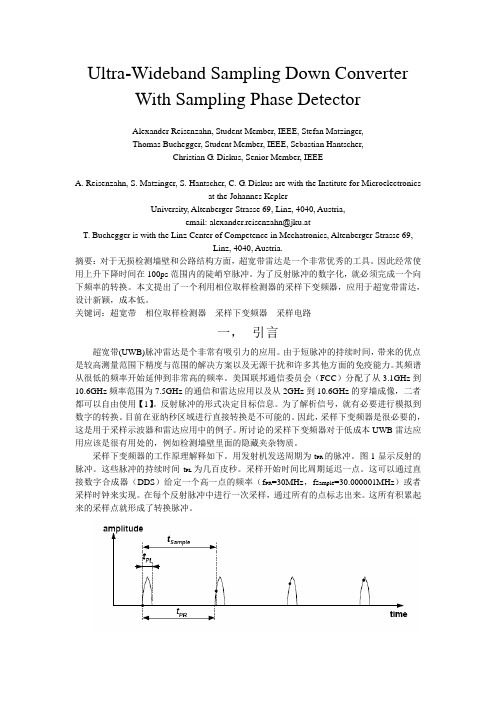
Ultra-Wideband Sampling Down Converter With Sampling Phase DetectorAlexander Reisenzahn, Student Member, IEEE, Stefan Matzinger,Thomas Buchegger, Student Member, IEEE, Sebastian Hantscher,Christian G. Diskus, Senior Member, IEEEA. Reisenzahn, S. Matzinger, S. Hantscher, C. G. Diskus are with the Institute for Microelectronicsat the Johannes KeplerUniversity, Altenberger-Strasse 69, Linz, 4040, Austria,email: alexander.reisenzahn@jku.atT. Buchegger is with the Linz Center of Competence in Mechatronics, Altenberger-Strasse 69,Linz, 4040, Austria.摘要:对于无损检测墙壁和公路结构方面,超宽带雷达是一个非常优秀的工具。
因此经常使用上升下降时间在100ps范围内的陡峭窄脉冲。
为了反射脉冲的数字化,就必须完成一个向下频率的转换。
本文提出了一个利用相位取样检测器的采样下变频器,应用于超宽带雷达,设计新颖,成本低。
关键词:超宽带相位取样检测器采样下变频器采样电路一,引言超宽带(UWB)脉冲雷达是个非常有吸引力的应用。
由于短脉冲的持续时间,带来的优点是较高测量范围下精度与范围的解决方案以及无源干扰和许多其他方面的免疫能力。
其频谱从很低的频率开始延伸到非常高的频率。
美国联邦通信委员会(FCC)分配了从3.1GHz到10.6GHz频率范围为7.5GHz的通信和雷达应用以及从2GHz到10.6GHz的穿墙成像,二者都可以自由使用【1】。
超宽带隐蔽式技术论文

超宽带无线通信技术姓名:卢高健单位:一队十七班学号:20118120426【摘要】过去二十年,无线技术在通信发展进程中一直扮演着重要角色。
伴随着移动通信十几年来的蓬勃发展以及3G、B3G等概念的日益普及,无线家族中的另一成员——宽带无线接入技术近年来异军突起。
而随着无线通信技术的发展,人们对高速短距离无线通信的要求越来越高。
超宽带(UWB)技术的出现,实现了短距离内超带宽、高速的数据传输。
其调制方式和多址技术的特点使得它具有其他无线通信技术所无法具有的很宽的带宽、高速的数据传输、功耗低、安全性能高等特点。
本文介绍了UWB的原理,基本理论,主要技术特点,部分关键技术及其应用和未来的发展情况,旨在对超宽带无线通信技术做一个初步的探索和研究。
【关键词】超宽带无线通信超宽带(UWB)技术调制方式多址方式【Abstract】In the past twenty years, wireless technology in communication, in the course of development, has always been playing an important role. With the mobile communication for more than a decade of booming development and 3 G, B3G concepts such as the increasing popularity of the wireless in the family, another member--broadband wireless access technology in recent years as a new force. But along with the development of wireless communication technology, people on the high-speed short-range wireless communication and taller to the requirement of. Ultra-wideband (UWB) technique appears, to achieve the short distances bandwidth, high speed of the data transmission. The modulation mode and multiple address thecharacteristics of the technology to make it are other wireless communication technology can have wide bandwidth and high speed data transfer, low power consumption, safety performance is higher characteristic. This paper introduces the principle of the basic theory, UWB, main technical characteristics, some key technology and its application and the development of the future, for the purpose of the broadband wireless communication technology to do a preliminary exploration and research.【Keywords】The broadband wireless communication ultra-wideband (UWB)technology modulation mode multi-access way一、超宽带无线通信简介1、超宽带无线通信概念无线通信技术是当前发展最迅速、最具活力的技术领域之一,在这个领域中,各种新技术、新方法层出不穷。
无线网络_外文翻译_外文文献_英文文献_无线局域网技术
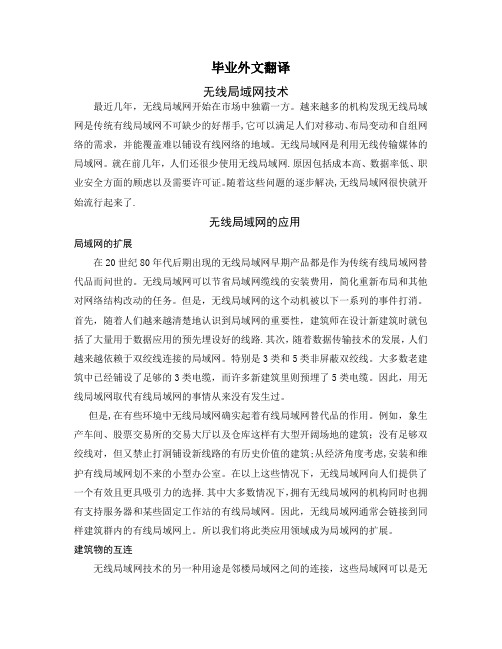
毕业外文翻译无线局域网技术最近几年,无线局域网开始在市场中独霸一方。
越来越多的机构发现无线局域网是传统有线局域网不可缺少的好帮手,它可以满足人们对移动、布局变动和自组网络的需求,并能覆盖难以铺设有线网络的地域。
无线局域网是利用无线传输媒体的局域网。
就在前几年,人们还很少使用无线局域网.原因包括成本高、数据率低、职业安全方面的顾虑以及需要许可证。
随着这些问题的逐步解决,无线局域网很快就开始流行起来了.无线局域网的应用局域网的扩展在20世纪80年代后期出现的无线局域网早期产品都是作为传统有线局域网替代品而问世的。
无线局域网可以节省局域网缆线的安装费用,简化重新布局和其他对网络结构改动的任务。
但是,无线局域网的这个动机被以下一系列的事件打消。
首先,随着人们越来越清楚地认识到局域网的重要性,建筑师在设计新建筑时就包括了大量用于数据应用的预先埋设好的线路.其次,随着数据传输技术的发展,人们越来越依赖于双绞线连接的局域网。
特别是3类和5类非屏蔽双绞线。
大多数老建筑中已经铺设了足够的3类电缆,而许多新建筑里则预埋了5类电缆。
因此,用无线局域网取代有线局域网的事情从来没有发生过。
但是,在有些环境中无线局域网确实起着有线局域网替代品的作用。
例如,象生产车间、股票交易所的交易大厅以及仓库这样有大型开阔场地的建筑;没有足够双绞线对,但又禁止打洞铺设新线路的有历史价值的建筑;从经济角度考虑,安装和维护有线局域网划不来的小型办公室。
在以上这些情况下,无线局域网向人们提供了一个有效且更具吸引力的选择.其中大多数情况下,拥有无线局域网的机构同时也拥有支持服务器和某些固定工作站的有线局域网。
因此,无线局域网通常会链接到同样建筑群内的有线局域网上。
所以我们将此类应用领域成为局域网的扩展。
建筑物的互连无线局域网技术的另一种用途是邻楼局域网之间的连接,这些局域网可以是无线的也可以是有线的。
在这种情况下,两个楼之间采用点对点的无线链接.被链接的设备通常是网桥或路由器。
最新毕设外文翻译 (英文原文 翻译)
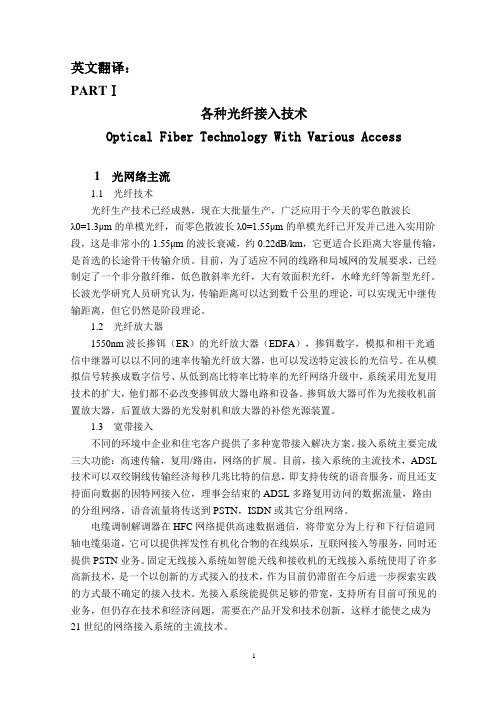
英文翻译:PARTⅠ各种光纤接入技术Optical Fiber Technology With Various Access1 光网络主流1.1 光纤技术光纤生产技术已经成熟,现在大批量生产,广泛应用于今天的零色散波长λ0=1.3μm的单模光纤,而零色散波长λ0=1.55μm的单模光纤已开发并已进入实用阶段,这是非常小的1.55μm的波长衰减,约0.22dB/km,它更适合长距离大容量传输,是首选的长途骨干传输介质。
目前,为了适应不同的线路和局域网的发展要求,已经制定了一个非分散纤维,低色散斜率光纤,大有效面积光纤,水峰光纤等新型光纤。
长波光学研究人员研究认为,传输距离可以达到数千公里的理论,可以实现无中继传输距离,但它仍然是阶段理论。
1.2 光纤放大器1550nm波长掺铒(ER)的光纤放大器(EDFA),掺铒数字,模拟和相干光通信中继器可以以不同的速率传输光纤放大器,也可以发送特定波长的光信号。
在从模拟信号转换成数字信号、从低到高比特率比特率的光纤网络升级中,系统采用光复用技术的扩大,他们都不必改变掺铒放大器电路和设备。
掺铒放大器可作为光接收机前置放大器,后置放大器的光发射机和放大器的补偿光源装置。
1.3 宽带接入不同的环境中企业和住宅客户提供了多种宽带接入解决方案。
接入系统主要完成三大功能:高速传输,复用/路由,网络的扩展。
目前,接入系统的主流技术,ADSL 技术可以双绞铜线传输经济每秒几兆比特的信息,即支持传统的语音服务,而且还支持面向数据的因特网接入位,理事会结束的ADSL多路复用访问的数据流量,路由的分组网络,语音流量将传送到PSTN,ISDN或其它分组网络。
电缆调制解调器在HFC网络提供高速数据通信,将带宽分为上行和下行信道同轴电缆渠道,它可以提供挥发性有机化合物的在线娱乐,互联网接入等服务,同时还提供PSTN业务。
固定无线接入系统如智能天线和接收机的无线接入系统使用了许多高新技术,是一个以创新的方式接入的技术,作为目前仍滞留在今后进一步探索实践的方式最不确定的接入技术。
超宽带无线技术
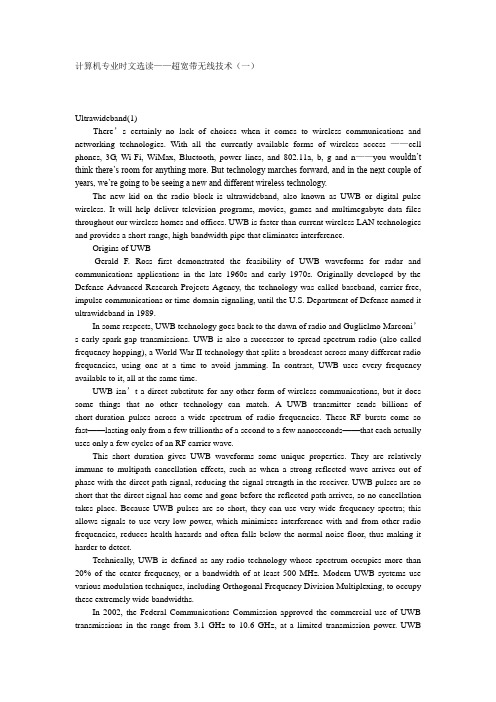
计算机专业时文选读——超宽带无线技术(一)Ultrawideband(1)There’s certainly no lack of choices when it comes to wireless communications and networking technologies. With all the currently available forms of wireless access ——cell phones, 3G, Wi-Fi, WiMax, Bluetooth, power lines, and 802.11a, b, g and n——you wou ldn’t think there’s room for anything more. But technology marches forward, and in the next couple of years, we’re going to be seeing a new and different wireless technology.The new kid on the radio block is ultrawideband, also known as UWB or digital pulse wireless. It will help deliver television programs, movies, games and multimegabyte data files throughout our wireless homes and offices. UWB is faster than current wireless LAN technologies and provides a short-range, high-bandwidth pipe that eliminates interference.Origins of UWBGerald F. Ross first demonstrated the feasibility of UWB waveforms for radar and communications applications in the late 1960s and early 1970s. Originally developed by the Defense Advanced Research Projects Agency, the technology was called baseband, carrier-free, impulse communications or time-domain signaling, until the U.S. Department of Defense named it ultrawideband in 1989.In some respects, UWB technology goes back to the dawn of radio and Guglielmo Marconi’s early spark-gap transmissions. UWB is also a successor to spread-spectrum radio (also called frequency-hopping), a World War II technology that splits a broadcast across many different radio frequencies, using one at a time to avoid jamming. In contrast, UWB uses every frequency available to it, all at the same time.UWB isn’t a direct substitute for any other form of wireless communications, but it does some things that no other technology can match. A UWB transmitter sends billions of short-duration pulses across a wide spectrum of radio frequencies. These RF bursts come so fast——lasting only from a few trillionths of a second to a few nanoseconds——that each actually uses only a few cycles of an RF carrier wave.This short duration gives UWB waveforms some unique properties. They are relatively immune to multipath cancellation effects, such as when a strong reflected wave arrives out of phase with the direct path signal, reducing the signal strength in the receiver. UWB pulses are so short that the direct signal has come and gone before the reflected path arrives, so no cancellation takes place. Because UWB pulses are so short, they can use very wide frequency spectra; this allows signals to use very low power, which minimizes interference with and from other radio frequencies, reduces health hazards and often falls below the normal noise floor, thus making it harder to detect.Technically, UWB is defined as any radio technology whose spectrum occupies more than 20% of the center frequency, or a bandwidth of at least 500 MHz. Modern UWB systems use various modulation techniques, including Orthogonal Frequency Division Multiplexing, to occupy these extremely wide bandwidths.In 2002, the Federal Communications Commission approved the commercial use of UWB transmissions in the range from 3.1 GHz to 10.6 GHz, at a limited transmission power. UWBsystems can, in principle, be designed to use nearly any part of the RF spectrum.This will allow the streaming of high-definition video between media servers and high-definition monitors, as well as the extremely fast transfer of files between servers and portable devices.(To Be Continued)超宽带无线技术(1)说到无线通信和联网技术时,肯定不乏选择。
英语翻译(中文)通信学院毕设必用
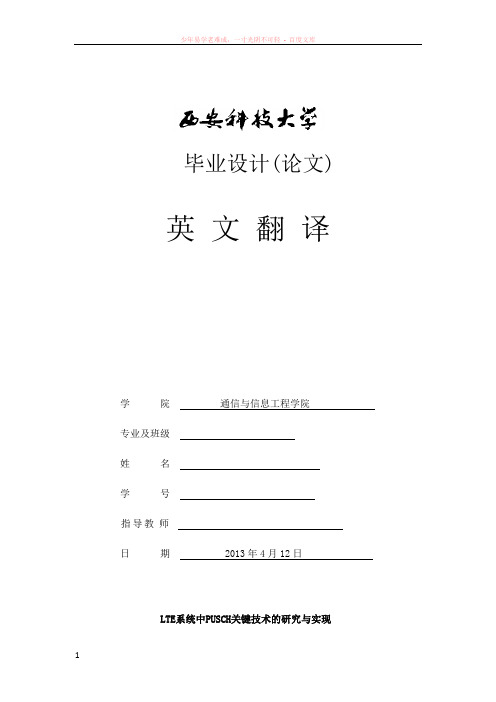
毕业设计(论文)英文翻译学院通信与信息工程学院专业及班级姓名学号指导教师日期 2013年4月12日LTE系统中PUSCH关键技术的研究与实现摘要新一代宽带无线移动通信网属于《国家中长期科学和技术发展规划纲要》中确立的十六个重大科技专项之一,其中的一项主要内容是窝移动通信系统的后续演进,包括通常所说的LTE技术、HSPA技术、4G等,代表了通信技术发展的主要方向。
本文结合在实验室参与的科研项目,对LTE.TDD系统中物理上行共享信道(PUSCH)进行了研究,在对单载波频分多址技术(SC.FDMA)进行理论分析的基础上,重点研究了其发送端的转换预编码及接收端的频域均衡技术,详细说明了相关功能模块在FPGA中的实现过程,并提出了LTE物理层基带开发平台方案。
PUSCH信道中的转换预编码可看成是34种混合基DFT运算。
宽带系统中的高DFT吞吐率是至关重要的,尤其是在DFT被多路数据通道共享时。
转换预编码中的每个起和接听全球范围内的电话通信。
早在第二代通信系统在市场出现以前,蜂窝通信研究团队就已将注意力转向第三代通信(3G)技术,把焦点放在其具有高比特使用率,高频谱效率以及语音电话和数据业务并存的特征上来。
1985年,国际电信联盟(ITU)发起未来公共陆地电信系统(PLTS)的研究。
十五年后,国际电信联盟出台了一系列建议,批准五种技术为第三代移动通信系统的基本技术。
2008年,移动运营公司部署了三种技术,即WCDMA、CDMA2000和TD.SCDMA。
同时,业界除了期待3G以外,也把目光转向了把SC.FDMA作为从手机到基站的主要候选方案的无线传输技术“长期演进(LTE)"上来。
3G标准于2007年最终确立之后,伴随着滚滚而来的移动宽带化浪潮,全球移动通信业关注的目光瞬间聚集在分别以LTE、UMB和802.16m为方向的3G下一步演进路线之争上。
路线的成败,决定了不同阵营的市场地位,决定了最终的产业格局。
- 1、下载文档前请自行甄别文档内容的完整性,平台不提供额外的编辑、内容补充、找答案等附加服务。
- 2、"仅部分预览"的文档,不可在线预览部分如存在完整性等问题,可反馈申请退款(可完整预览的文档不适用该条件!)。
- 3、如文档侵犯您的权益,请联系客服反馈,我们会尽快为您处理(人工客服工作时间:9:00-18:30)。
外文文献翻译超宽带技术的短期或中期范围内的无线通信杰夫福斯特,英特尔架构实验室,英特尔公司埃文格林,英特尔架构实验室,英特尔公司斯里尼瓦萨,英特尔架构实验室,英特尔公司大卫利珀,英特尔部连接的产品,英特尔公司关键字:超宽带,无线,通讯,局域网,无源光网络摘要超宽带(UWB)技术可以大致的被定义为一个占有超过25%中心频率的带宽,或者涨幅比为1.5GHz的带宽的任何无线传输方案。
美国联邦通讯委员会(FCC)目前正在制定措施限制超宽带通信系统的辐射排放量,与家用电脑管理的辐射排放量相同,在无牌经营的基础上部署第15.209有目的的散热辐射规则。
这一规则的改变将使UWB 的可以启用的频谱更有效地利用现有的窄带系统来覆盖,并使得有用的频谱更为有效,但目前这是不允许的。
本质上这些设备可以在任何特定地点频谱的未使用的部分中使用。
通过FCC最近的这些发展给了英特尔一个独特的机会来发展硬件设施,它们可以依靠存在于无线领域大量的潜在的优势来利用巨大的可用频谱,而且正在提供一个用来驱动未来的高速率应用引擎的整个行业的构思。
英特尔®架构实验室(的IAL)目前正在研究超宽带技术,以更好地了解它的好处、缺陷和使用高速率通信带来的技术挑战。
本文从潜在的应用程序的监管障碍到可能的实现和未来的挑战向读者介绍了这项技术。
简介宽带(UWB)的技术流行于20世纪80年代,因为信号的宽带性质使它具有非常准确的计时信息,使它仅用于基于雷达的应用程序,然而由于在高速交换技术的最新发展,使UWB对于低成本的消费通信应用变得更加有吸引力的。
英特尔架构实验室(IAL)目前正在内部资助研究项目,其目的是进一步探讨延伸到高速率通信领域超宽带技术的潜在好处和未来的挑战。
虽然短期超宽带(UWB)不是很有说服性,但它确实有助于从传统的“窄带”系统技术以及新的“宽带”系统通常描述中提到的未来3G蜂窝技术中分离出这种技术。
UWB和其他“窄带”或“宽带”系统之间有两个的主要区别。
首先,超宽带系统的带宽,如美国联邦通讯委员会(FCC)的定义,是25%以上的或超过1.5GHz的中心频率。
显然,这种带宽远远大于目前任何技术所采用的通信带宽。
其次,UWB 是一个典型的实施载波方式。
传统的“窄带”和“宽带”系统使用无线电频率(RF)基带运载在频域中的信号,并且这些系统允许被操作。
相反,超宽带的实现可以直接调节一个“脉冲”,这种脉冲有一个非常尖锐的上升和下降时间,因此,在占用的波形产生几个GHz的带宽。
虽然产生一个UWB波形有许多其他的方法,但在本文中,我们着重叙述脉冲的超宽带波形。
无线替代的手段为了了解在无线通信中超宽带无线通信适用于哪些目前的趋势,我们需要考虑一般通信系统试图解决的问题。
尤其是,如果无线是一个理想的媒介,可以用它来传送1.大量的数据,2.远距离传输,3.传输速度快,4.多用户,5.同时性。
不幸的是,不可能寻在实现一个同时具备这五种特性的通信和双向通信流系统,如果其他的要做好,必须放弃一个或多个特性。
原来的无线系统用于测量大型桥梁的距离,以便使双方联系在一起。
然而,最近的一个无线电历史显示了对于其他四个属性的距离费用存在明显提高的趋势。
蜂窝电话系统就是最明显的例子,覆盖300米到30公里的范围。
短距离允许频谱再利用,从而服务更多的用户,并且系统是可行的,因为它们是由一个基本的有线基础设施中的移动电话网络来支撑的。
在过去数年,甚至更短距离系统,从10到100米,已经开始出现,带动了以数据应用为主。
在这里,有线互联网是基础设施,而不是电话网络。
许多人期待短距离无线和有线互联网结合成一个快速增长的补充数据,语音,音频和视频的下一代的蜂窝系统。
四大趋势正在推动短距离尤其是超宽带无线通信的普及:(1)对于无线数据能力的便携式设备日益增加的对高带宽需求,以及低于目前可用技术的成本和功耗。
(2)拥挤的频谱分割却以传统的方式被监管部门分段和控制。
(3)高速有线接入的企业,家庭上网速度,和公共空间的增长。
(4)信号处理半导体成本和功耗的收缩。
趋势1和2要求系统不仅仅是提供高比特率峰值,而且还需要高容量,以及空间,其中空间容量被定义为/秒/平方米/位。
正如电话功能的蜂窝电话网络,趋势3使高带宽成为可能,包括在建的服务提供低功率短距离如使用蓝牙和IEEE 802.11成为可能。
最后,趋势4让这些本来在几年前不切实际技术的信号处理的使用成为了可能。
,使超宽带(UWB)技术实用成为最终的趋势。
按预期,新兴的短期和媒介变化无线标准各有不同,隐含的空间容量大小分配使用。
例如:(1)IEEE802.11b有100米额定工作范围。
在2.4GHz ISM频段,可用频谱大约为80MHz。
因此,在一个有100米,3 22MHz IEEE 802.11b 的系统能在不干扰的基础上,各有一峰值为11Mbps的速度半径。
该合计速度33Mbps,由圆的面积划分,产量约1000比特/秒/平方米的空间容量。
(2)蓝牙,是一种低功耗模式,具有在额定10米范围内,峰值在空中的1Mbps的速度。
研究表明,大约10蓝牙“微网”能以最小的退化同时操作在同一个10米的圆一个10Mbps的产生总的速度。
除以圆的面积这个速度产生约30,000比特/秒/平方米的空间容量。
(3)IEEE802.11a是预计有一个50米的工作范围和54Mbps的峰值速度的项目。
由于在5GHz范围内的U型国家信息基础设施带下部的200MHz的可用频谱,12这种系统可以同时运行在一个50米环路中,并可以聚集648Mbps的速度。
预计该系统的空间容量约为83,000比特/秒/平方米。
(4)UWB系统按照他们的预测具有很大的不同功能,但有超宽带技术的开发商已经测量在10米范围和项目等六大系统可以在同一个10米半径有超过50Mbps的峰值并且只有很少的操作降解速度 。
按照同样的程序,预计该系统的空间能力将超过100万比特/秒/ 平方。
目前的低数据速率无线局域网(WLAN)和无线个人区域网络(WPAN)能够达到1-10Mbps的数据传输速率,通常用于诸如分组交换数据和无线语音电话应用,使用时分多址(TDMA)语音电路。
例如技术支持这些应用的IEEE 802.11(Wi-Fi的)蓝牙和HomeRF网络标准。
由于802.11和ETSI BRAN HiperLAN / 2 *标准(相当于欧洲的802.11)已添加原始数据的物理层速率高达54Mbps规格,应用空间扩大到包括音频/视频这些数据应用的更高速率。
这些不同类型的流量对于服务参数的不同有不同的条件要求,量化为每个应用程序对这些用户的网络性能。
因此,例如,语音电话和视频电话会议应用在延迟和抖动性能方面有严格要求。
音频或者视频的应用需要大量带宽,可能需要关闭同步(例如,连接立体声扬声器环绕声系统)。
超宽带(UWB)系统,与他们在短距离上相比具有非常大的数据速度的潜力,自然是要为网络的数据源和汇聚高宽带这类使用。
因此,这将是在向MAC设计时考虑这些超宽带系统的MAC层设计等标准进行。
MAC层最重要的无线网络功能,包括信道接入控制,保持服务质量(QoS),并提供安全性。
外文文献原文Ultra-Wideband Technology for Short-or Medium-RangeWireless CommunicationsJeff Foerster, Intel Architecture Labs, Intel Corp.Evan Green, Intel Architecture Labs, Intel Corp.Srinivasa Somayazulu, Intel Architecture Labs, Intel Corp.David Leeper, Intel Connected Products Division, Intel Corp. Index words: UWB, wireless, communications, LAN, PANABSTRACTUltra-Wideband (UWB) technology is loosely defined as any wireless transmission scheme that occupies a bandwidth of more than 25% of a center frequency, or more than 1.5GHz. The Federal Communications Commission (FCC) is currently working on setting emissions limits that would allow UWB communication systems to be deployed on an unlicensed basis following the Part 15.209 rules for radiated emissions of intentional radiators, the same rules governing the radiated emissions from home computers, for example.This rule change would allow UWB-enabled devices to overlay existing narrowband systems, which is currently not allowed, and result in a much more efficient use of the available spectrum. Devices could, in essence, fill in the unused portions of the frequency spectrum in any particular location.These recent developments by the FCC give Intel a unique opportunity to develop equipment that could potentially take advantage of the vast amount of usable spectrum that exists in the wireless space, and that could provide an engine to drive the future high-rate applications that are being conceived throughout this industry.Intel® Architecture Labs (IAL) is currently researching UWB technology in order to better understand its benefits, limitations, and technical challenges when used for high-rate communications. This paper introduces the reader to this technology, from potential applications toregulatory hurdles, to possible implementations and future challenges. INTRODUCTIONUltra-Wideband (UWB) technology has been around since the 1980s, but it has been mainly used for radar-based applications until now (see [1] and the references therein), because of the wideband nature of the signal that results in very accurate timing information. However, due to recent developments in high-speed switching technology, UWB is becoming more attractive for lowcost consumer communications applications (as detailed in the “Implementation Advantages” section of this paper). Intel Architecture Labs (IAL) is currently working on an internally funded research project whose intent is to further explore the potential benefits and future challenges for extending UWB technology into the high-rate communications arena.Although the term Ultra-Wideband (UWB) is not very descriptive, it does help to separate this technology from more traditional “narrowband” systems as well as newer “wideband” systems typically referred to in the literature describing the future 3G cellular technology. There are two main differences between UWB and other “narrowband” or “wideband” systems. First, the bandwidth of UWB systems, as defined by the Federal Communications Commission (FCC) in [2], is more than 25% of a center frequency or more than 1.5GHz. Clearly, this bandwidth is much greater than the bandwidth used by any current technology for communication. Second, UWB is typically implemented in a carrierless fashion. Conventional “narrowband” and “wideband” systems use Radio Frequency (RF) carriers to move the signal in the frequency domain from baseband to the actual carrier frequency where the system is allowed to operate. Conversely, UWB implementations can directly modulate an “impulse” that has a very sharp rise and fall time, thus resulting in a waveform that occupies several GHz of bandwidth. Although there are other methods for generating a UWB waveform (using a chirped signal, for example), in this paper, we focus on the impulse-based UWB waveform.but, first, a breakdown of how this paper is organized. WIRELESS ALTERNATIVESIn order to understand where UWB fits in with the current trends in wireless communications, we need to consider the general problem thatcommunications systems try to solve. Specifically, if wireless were an ideal medium, we could use it to send.1. a lot of data,2. very far,3. very fast,4. for many users,5. all at once.Unfortunately, it is impossible to achieve all five attributes simultaneously for systems supporting unique, private, two-way communication streams; one or more have to be given up if the others are to do well. Original wireless systems were built to bridge large distances in order to link two parties together. However, recent history of radio shows a clear trend toward improving on the other four attributes at the expense of distance. Cellular telephony is the most obvious example, covering distances of 30 kilometers to as little as 300 meters. Shorter distances allow for spectrum reuse, thereby serving more users, and the systems are practical because they are supported by an underlying wired infrastructure– the telephone network in the case of cellular. In the past few years, even shorter range systems, from 10 to 100 meters, have begun emerging, driven primarily by data applications. Here, the Internet is the underlying wired infrastructure, rather than the telephone network. Many expect the combination of short-range wireless and wired Internet tobecome a fast-growing complement to nextgeneration cellular systems for data, voice, audio, and video. Four trends are driving short-range wireless in general and ultra-wideband in particular:1. The growing demand for wireless data capability in portable devices at higher bandwidth but lower in cost and power consumption than currently available.2. Crowding in the spectrum that is segmented and licensed by regulatory authorities in traditional ways.3. The growth of high-speed wired access to the Internet in enterprises, homes, and public spaces.4. Shrinking semiconductor cost and power consumption for signal processing.Trends 1 and 2 favor systems that offer not just high-peak bit rates, but high spatial capacity1 as well, where spatial capacity is defined as bits/sec/square-meter. Just as the telephone network enabled cellular telephony, Trend 3 makes possible high-bandwidth, in-building service provision to low-power portable devices using short-range wireless standards like Bluetooth () and IEEE 802.11 (/groups/802). Finally, Trend 4 makes possible the use of signal processing techniques that would have been impractical only a few years ago. It is this final trend that makes Ultra-Wideband (UWB) technology practical. When used as intended, the emerging short- andmedium-range wireless standards vary widely in their implicit spatial capacities. Forexample:1.IEEE 802.11b has a rated operating range of 100 meters. In the 2.4GHz ISM band, there is about 80MHz of useable spectrum. Hence, in a circle with a radius of 100 meters, three 22MHz IEEE 802.11b systems can operate on a non-interfering basis, each offering a peak over-the-air speed of 11Mbps. The total aggregate speed of 33Mbps, divided by the area of the circle, yields a spatial capacity of approximately 1,000 bits/sec/square-meter.2.Bluetooth, in its low-power mode, has a rated 10-meter range and a peak over-the-air speed of 1Mbps. Studies have shown that approximately 10 Bluetooth “piconets” can operate simultaneously in the same 10-meter circle with minimal degradation yielding an aggregate speed of 10Mbps [3]. Dividing this speed by the area of the circle produces a spatial capacity of approximately 30,000 bits/sec/square-meter.3.IEEE 802.11a is projected to have an operating range of 50 meters anda peak speed of 54Mbps. Given the 200MHz of available spectrum within the lower part of the 5GHz U-NII band, 12 such systems can operate simultaneously within a 50-meter circle with minimal degradation, for an aggregate speed of 648Mbps. The projected spatial capacity of this system is therefore approximately 83,000 bits/sec/square-meter.4.UWB systems vary widely in their projected capabilities, but one UWB technology developer has measured peak speeds of over 50Mbps at a range of 10 meters and projects that six such systems could operate within the same 10-meter radius circle with only minimal degradation. Following the same procedure, the projected spatial capacity for this system would be over 1,000,000 bits/sec/square-meterCurrent low data-rate Wireless Local Area Networks (WLANs) and Wireless Personal Area Networks (WPANs), which have data rates of ~1-10Mbps, are typically used for applications such as packet-switched data and cordless voice telephony, using Time Division Multiple Access (TDMA) voice circuits. Example technologies supporting these applications are the IEEE 802.11b (Wi-Fi)*, Bluetooth∗, and HomeRF* networking standards. As the IEEE 802.11 and ETSI BRAN HiperLAN/2* standards (the European equivalent of 802.11) have added physical layer specifications with raw data rates up to 54Mbps, the application space is enlarging to include audio/video applications that are enabled by these higher data rates. These diverse traffic types all have different requirements in terms of the service parameters that quantify the network performance for a user of each of those applications. Thus, for example, voice telephony and video teleconferencing applications place tough demands on the latency and jitter performance. Audio/video applications require large amounts of bandwidth and may need closesynchronization (e.g., connecting stereo speakers in a surround sound system). Ultra-Wideband (UWB) systems, with their potential for extremely large datarates over short distances, are naturally going to be used for networking these kinds of high-bandwidth/delaycritical data sources and sinks. Hence, it would be natural to look at the approaches to the MAC design undertaken in these other standards when considering the MAC layer design for UWB systems. The most important functions of the MAC layer for a wireless network include controlling channel access, maintaining Quality of Service (QoS), and providing security.。
